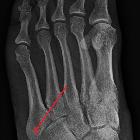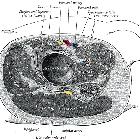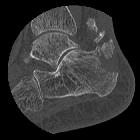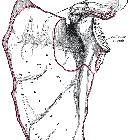Hamstring injury













Hamstring injuries are the most common muscle injury, and are very common in athletes and can cause a significant loss of playing time depending on the sport.
Epidemiology
Amongst professional athletes, hamstring injuries are reported to make up 15% of all injuries in Australian Football players and 12% of injuries amongst soccer players .
Pathology
Location
As with any muscle injury, the hamstrings can be injured at multiple possible points :
- origin: ischial tuberosity avulsion injury
- proximal free tendon
- myotendinous junction (most common)
- proximal more commonly injured than distal
- biceps femoris most common hamstring muscle injured
- epimysial/myofascial: most common in biceps femoris proximal to the fusion of the short and long heads
- intramuscular (rare)
- distal free tendon
- semitendinosus distal tendon injury (most common)
- semimembranosus distal tendon injury
Mechanism
Hamstring injuries can result from :
- acute injury
- type 1
- eccentric contraction during high-speed running for limb deceleration in preparation for foot strike
- proximal myotendinous junction of biceps femoris most commonly injured
- type 2
- excessive lengthening of the hamstring (e.g. dancing, slide tackles, high kicking)
- proximal free tendon of semimembranosus
- type 1
- chronic overuse
- most commonly seen in runners (over all distances)
- proximal hamstring origin tendinopathy, with semimembranosus most commonly affected
Classification
Clinically, hamstring injuries can be graded as :
- grade 1: no appreciable muscle tearing, <5% loss of function/strength
- grade 2: damage to the musculotendinous junction (MTJ); reduced strength; some residual function
- grade 3: complete tear of the MTJ; loss function +/- a palpable gap
There are numerous imaging classification systems including:
- British Athletics muscle injury classification (MRI-based)
Radiographic features
There are no unique features of hamstring-specific injuries. Please see the general articles on muscle injury and tendon pathology for further details.
Treatment and prognosis
Return to play is largely predicted by clinical assessment with poor correlation between imaging-based grading systems and time to return to play . Prognostic factors affecting a longer rehabilitation and thus delayed return to play include :
- proximal free tendon injury
- proximity to the ischial tuberosity
- ≥ grade 3 injury (i.e. grade 1 and 2 injuries are not associated with time to return to play)
The recurrence rate is ~20% (range 12-31%) and can occur within a short timeframe (e.g. 2 weeks) after return to play .
Differential diagnosis
Patients presenting with posterior thigh pain suspicious for a hamstring injury but have a negative MRI (so-called "MRI-negative hamstring injury") may have symptoms from :
- lumbar spine referred pain
- fascial injury
- gluteal trigger points
Siehe auch:
- Morbus Osgood-Schlatter
- Avulsionsfraktur Basis Metatarsale 5
- Tuber ischiadicum
- Avulsionsfraktur
- Stieda-Pellegrini-Köhler-Schatten
- Oberschenkelmuskeln
- Patellaspitzensyndrom
- calcaneal tuberosity avulsion fracture
- Morbus Sinding-Larsen-Johansson
- Avulsionsfraktur der Tuberositas tibiae
- Abrissfraktur Epikondylus ulnaris
- Musculus subscapularis
- Rotatorenmanschette
- Ansatz ischiocrurale Muskulatur
- Adduktorenruptur
- distal tears of the hamstring muscles
und weiter:

 Assoziationen und Differentialdiagnosen zu Hamstring injuries:
Assoziationen und Differentialdiagnosen zu Hamstring injuries:













